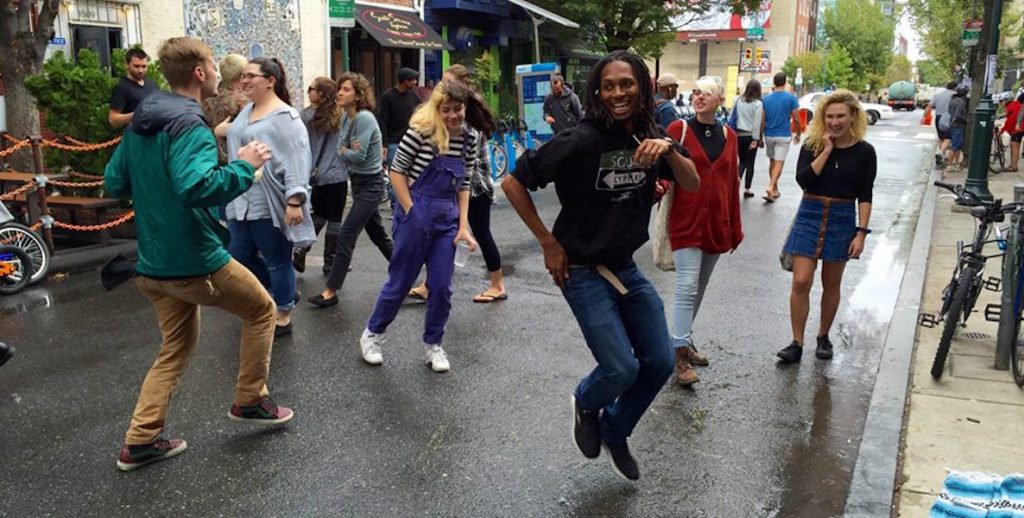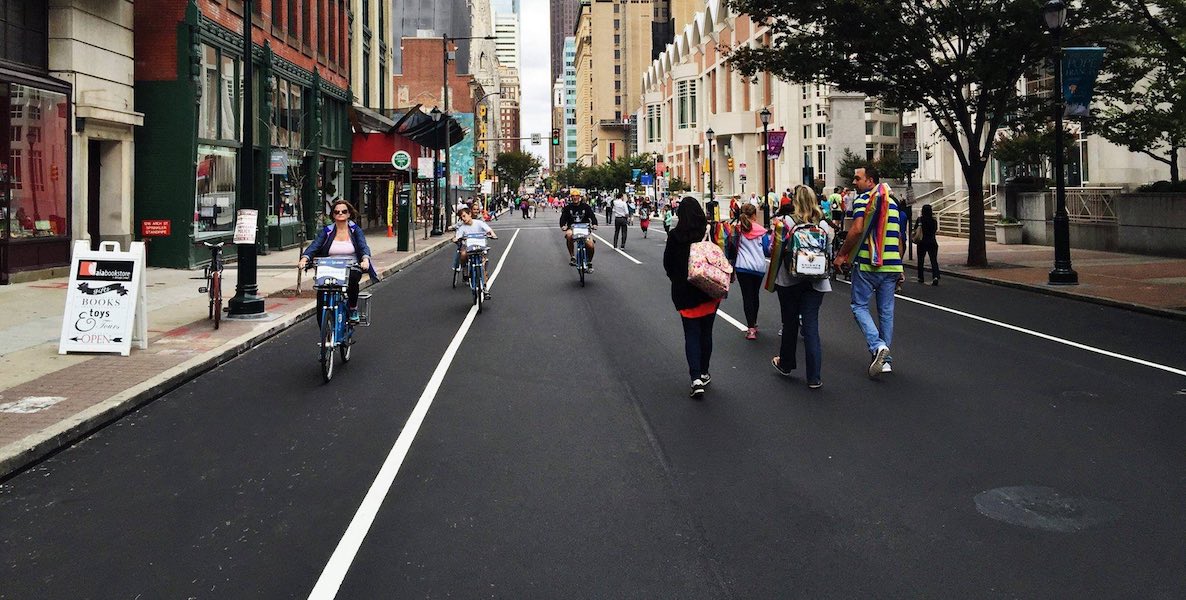The day was beautiful, the crowds joyous, and the air infinitely more breathable in Philadelphia—at least on South Street, on September 24th, during the city’s first-ever (not counting the Pope) Philly Free Streets Day. Open Streets PHL, an advocacy group created on the good vibes of the Pope visit, immediately declared the car-free event a success. The Managing Director’s Office of Transit & Infrastructure Systems, the city office that planned the event and placed the trash bins, is waiting to complete its evaluation before comment. Before the big day, I wrote about the history of the city street as a public space, and the lessons to be learned from the car industry.
After, I collected accounts from those who were there to find out for myself: Did Philly pull off a successful Free Streets Day?
A SINGLE STREET?
Before the day, some were skeptical of the car-free route—which was, essentially, just the length of South Street. At Philly Mag, Victor Fiorillo declared that Philly’s Big Open Streets Event Is One Big Disappointment because, he said, not closing the entire city center pointed to a half-ass attempt.
It’s true that the magic of that Pope Francis visit was the opportunity to freely explore vast swaths of the city. But that was a citywide security measure. Those who live and work near South Street underscored why that doesn’t really make sense for single-day events. Curtis Kise, owner of South Street’s Neighborhood Books, said even widening the event to include Lombard and Bainbridge streets is probably not a great idea. “Event setup began around 3 a.m., and a lot of cars were towed,” said Kise. “I’m sure residents weren’t happy.”
Indeed, the city apologized for a handful of mistaken tows, assuring refunds. A resident, picking up her towed vehicle, noted, “I am disappointed that such a lovely event is now tarnished to the residents that live here.”
Closing a street in such a dense urban neighborhood is a nuisance to the locals, and closing more streets is even more disruptive to neighbors.
And a funny thing happened. It didn’t feel like a half-ass attempt. Although it was just one street, there was a palpable energy of happiness and excitement. “It’s really not the number of streets,” says attendee Lisa Drago. “It’s the energy and community, and it was so beautiful.”
Even Fiorillo cedes that most Free Streets style events around the world typically close down only one route, including Pittsburgh’s OpenStreetsPGH, or Fargo, North Dakota’s Streets Alive! After all, this great achievement for Philadelphia, will be short-lived if residents refuse to host it.
FOR NEXT TIME: The city says it started posting No Parking flyers on Thursday and was finished by 8 p.m. Friday. Towing began 3 a.m. Saturday. It’s not like Free Streets Day snuck up on them. Next time, let’s give residents more notice.
FLOW OF (NON-AUTO) TRAFFIC
Big crowds certainly poured out for Free Streets, creating a convivial and energetic atmosphere. But there was a drawback: On the east end of South Street, bikers were visibly frustrated as they tried to navigate the crowd.
On the Open Streets Facebook page, a user commented, “It was like riding on the sidewalk but with thousands of people. Aren’t there already pedestrian-focused open streets?”
Although activities were wisely located on side streets, to leave South Street open as a thoroughfare, there still wasn’t enough space to handle the crowds. South Street is not a particularly wide street—imagine the difference if the event was on Columbus Boulevard. But also, Philadelphia Free Streets, for better or worse, wasn’t geared toward any single audience the way the Ciclovia in Bogota, Colombia, or the CicLAvia in Los Angeles, are aimed at cyclists.
Somehow, runners got the message, though: Groups like the Philly Distance Runners organized runs at 8 a.m., taking advantage of cleared roads, before the crowds came to clog up the event.
FOR NEXT TIME: There are a few ways to handle different types of traffic. One is to separate them entirely—give bicyclists and runners their own ‘adult swim’ time, earlier in the day. In addition to offering these go-getters the experience they want, it also sets the expectation that accelerated transport will not be available all day. Or manufacture more space for the event, either by targeting our larger streets (Columbus, Broad Street, or American Street come to mind), or by closing two streets, one for east traffic and one for west.
BIG BUSINESS
One of the city’s stated goals for Philly Free Streets was to help residents “explore the communities and businesses along the route.” But this is one area where Free Streets would be wise to avoid replicating Pope Francis’s 2014 visit.
After being promised 1.5 million visitors, with all their spending power, many businesses instead suffered. The Midtown III restaurant, for example, spent $7,500 on food, and another $1,000 on a parking space, all wasted. And with sales down more than 50 percent, Robek’s, a juice and smoothie shop, decided to close early Sunday. Meryl Levitz, president and chief executive of Visit Philadelphia opined, “To look at a grassroots spiritual event in terms of immediate economic benefit is asking too much of it.”
So how did businesses fare at Philly Free Streets? The results are mixed. Food and drink venues like Ants Pants Cafe, and Little Spoon, reported lots of new faces. Neighborhood Books took advantage of the event by hosting a sidewalk sale. Stores like Repo Records and Image on South reported no change in business, or even a drop in sales. Even worse, at least two businesses I spoke to were caught off guard by the event. When I asked the convenience store at 13th and South, they said “the event was more about walking through,” and that the crowd was “more of a Whole Foods audience, anyways.”
Most promising were the businesses that saw no benefit, but still support more Free Streets. Although Philadelphia’s Magic Gardens cited lower attendance during the event, you couldn’t tell from their enthusiasm. “It felt so positive and was such a happy celebration,” said Emily Smith, executive director of Magic Gardens. “Honestly, I was sad I didn’t get a chance to rent an Indego and participate—it was really inspiring!”
Even Rich Frank, owner of Fat Tuesday, who saw no new visitors and admits “it’s not my target crowd,” still supports “any attempts trying to bring people down to [South] Street.”
FOR NEXT TIME: Frankly, the “boon for business” pitching of a civic-minded event like Free Streets feels wrong, and places undue pressure on the event. This pitch needs to shift from guaranteed dollars to guaranteed exposure, with an emphasis on building community.
And while the city did a decent attempt to get the word out (with robocalls, and some flyering) no businesses were surprised by the event. The thing about business owners is that they’re sitting ducks: from open to close, they are there in that store. Send a letter, send a text message, send a street team to stop in the stores. Or better yet, hold a planning meeting with local business associations to hear their voice. For Free Streets to occur two to three times a year, we need businesses to be on board.
END OF EVENT
From 8 a.m. to 1 p.m., the Free Streets hosted not a single tank of gas. But after five hours of different use, how, you may ask, did we make the transition from pedestrian heaven to vehicular traffic? Not gracefully.
Street cleaning machines were dispatched to wash off all the chalk wayfinding. Flatbed trucks began collecting all the barricades. Perhaps most egregious were the leaf blowers. Meant to clean the debris, some attendees felt, as one Facebook commenter put it, like they “were literally using leaf blowers to make everyone scurry—it was a horrible ending to an otherwise beautiful day.”
FOR NEXT TIME: Get rid of the leaf blowers. Yes, it’s important to re-establish the rules of the road, but compressed air is not the way to do it. Bring down a parade float, or invite the Simeone Auto Museum to roll its vintage wheels to re-open the car route. Co-ordinate a street wide “cutting of the caution tape.” Instead of an abrupt transition, find a better way to celebrate the emotions of the day.
And, longer hours! More hours means more time to play, explore, soak in the good vibes. That transition back to the 1905 street will always be tough, but a setting sun just might be the perfect sendoff.


